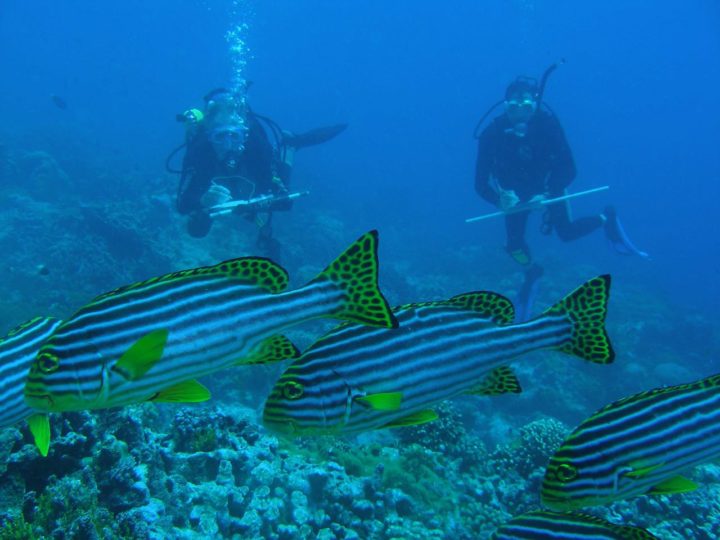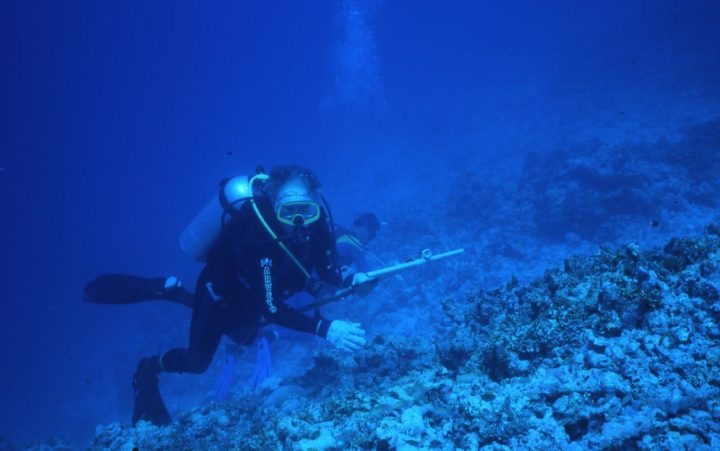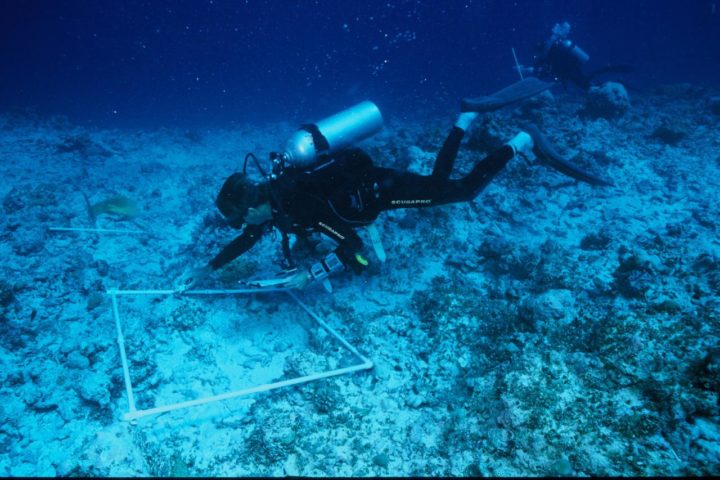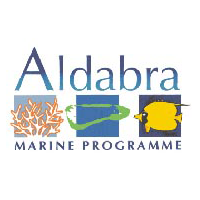AMP expedition objectives
The 1999 Aldabra Marine Programme Expedition. (See links and downloads section for report)
- Objectives
The main objectives were to:
1. Establish a permanent system for the long-term monitoring of benthic and reef fish communities;
2. Conduct an assessment of the diversity and abundance of corals and fishes;
3. Quantify bleaching impacts on corals;
4. Establish a system for assessing larval supply of coral species to the lagoon and reef slope;
5. Resurvey the Drew (1997) coral transect adjacent to the settlement at Ile Picard.
- All of these objectives were completed (Teleki et al. 1999). Seven permanent survey sites were established on the outer reefs along the northern and western coasts of Aldabra. The survey sites were located for an even geographic distribution around the atoll, and to coincide with previous transects by Barnes et al. (1971) and Drew (1977).
- At each survey site, permanent 50 m long transects were located along the 10 m and 20 m depth contours, except at one site the transects were along the 5 m and 15m contours due to limited depths of the coral.
- Surveys on each transect assessed the diversity and abundance of corals and fishes, and quantified the impacts of the 1998 bleaching-event. During this first phase the corals on the Drew (1977) transect were resurveyed and it was concluded that the corals were beginning to recover.

The 2001 Aldabra Marine Programme Expedition (Click here for report)
- The original plan to repeat the November 1999 surveys in November 2000 was not possible due to funding constraints that prevented adequate lead-time to stage the expedition.
- The intensive diving operations required to conduct the AMP surveys have the highest probability of avoiding high winds and other encumbering weather problems during the October-November and February-March weather-windows. After staging in Mahe, Republic of the Seychelles, the vessel transit time to Aldbara Atoll, and return, is approximately 3.5 days each way.
- This transit time, combined with funding, provisions, and personnel factors, establishes a limit on the time on-station at Aldabra at approximately 15 days for each expedition.
- The second AMP expedition was at Aldabra during 8-22 February 2001.
Objectives
The main objectives of the February 2001 AMP expedition were to:
1. Repeat the quantified transects of corals and fishes at the seven permanent survey sites established in 1999;
2. Establish additional permanent survey sites on the outer reef and conduct quantified benchmark transects of corals and fishes at these sites;
3. Establish permanent survey sites in the lagoon and conduct quantified benchmark transects of corals at these sites;
4. Conduct quantified coral recruitment transects at selected locations on the outer reef and in the lagoon;
5. Tag coral recruits at selected locations on the outer reef to monitor growth and survival;
6. Deploy temperature data loggers at selected locations on the outer reef and in the lagoon.
The secondary objectives of this expedition were to:
1. Conduct checklist-surveys of fishes at the outer reef and lagoon survey sites;
2. Enhance the repeatability to the transects at the permanent sites using sub-surface floats and lead-core line to mark the 50 m transect lines;
3. Conduct quantified transects of Echinometra sp. and Diadema sp. (black-spined urchins) at selected locations on the outer reef (Click here);
Conduct training exercises for Aldabra Station staff in the methods for coral recruitment surveys, urchin surveys, and temperature logger data retrieval.

The 2002 Aldabra Marine Programme Phase III (Click here for report)
The main objectives were to:
• Repeat the coral and fish transects at the eleven permanent survey sites established at Aldabra between 1999 and 2001;
• Survey an area of reef on the exposed southeastern coast of Aldabra;
• Re-measure corals tagged at selected sites at Aldabra in 2001, and tag more corals where possible;
• Establish new permanent monitoring survey sites at three islands, Assomption, Astove and St. Pierre, east of Aldabra;
• Conduct coral recruitment quadrats at all survey sites at Aldabra, Assomption, Astove and St. Pierre;
• Survey Echinoderm populations at Assomption, Astove and St. Pierre;
• Download temperature loggers deployed at Aldabra in 2001 and deploy new loggers at selected sites;
• Deploy temperature data loggers at Assomption, Astove and St. Pierre.
The secondary objectives of this phase were to:
• Mark all permanent 50m transects with lead core line;
• Continue training Seychellois rangers in marine survey techniques;
Survey the reef habitats around Assomption, Astove and St. Pierre.
All of the goals of the AMP Phase III 2002 expedition were met with two exceptions:
- Firstly, the AMP is committed to training Seychellois rangers in marine survey techniques and intended to do so during Phase III.
- However, due to funding difficulties the expedition was not confirmed in time to find suitable candidates and arrange for their participation in the expedition. It is hoped that timing of future expeditions will allow training of rangers to continue.
- The prospects for Aldabra Research Station staff to conduct marine surveys were improved in March 2002 thanks to the donation of diving equipment by an Italian film crew.
- An AMP member was able to train Station staff in the operation of the air compressor and procedures for filling diving cylinders.
- Secondly, the temperature data loggers were not deployed as planned due to a serious logger design fault. New loggers will be deployed in future expeditions.
- The AMP has continued to operate a long term marine programme at Aldabra, and has expanded its work eastward to include Assomption, Astove and St. Pierre.
- Inclusion of new sites progressively further from Aldabra, and with increasing anthropogenic influence, will provide valuable long term comparative data.
- The study will be increased in 2003 with the establishment of a new lagoon site at Aldabra at a location of exceptional coral cover located in March 2002.
- It is also hoped that a study of “coralliths” will be initiated within the lagoon and there are plans to conduct regular aerial surveys of the lagoon to initiate habitat mapping and species counts for this unique ecosystem.


